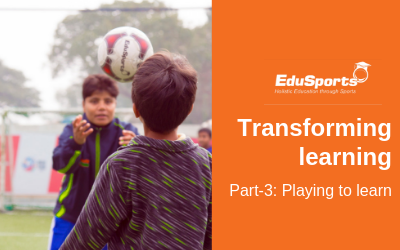“To succeed is to have failed” – learning from failures

Empowering girls through sport
Today, however, the positive impact of sports on girls is a widely accepted phenomenon. Regular participation in sports is associated with emotional benefits, a healthier and better quality of life and reduced threats of untimely diseases. Several research studies show that participation in physical activity and sports can increase a woman’s self esteem and overall well-being (Feltes, 1998).
Girls benefit from sports participation at many levels. Some of these benefits are highlighted by a study conducted by McEwin (1981) which includes benefits ranging from physical fitness to psychological balance. To sum up, five major benefits of sports and physical activities for girls are:
1. Better Physical Health
The benefits of regular physical activity are well established (Read: https://www.sportzvillage.com/schools//let-the-children-play/) and its influence on a girl’s health is two pronged. Firstly, it builds a positive relationship between physical activity and a host of factors affecting girls’ physical health, including diabetes, blood pressure, body fat etc. (Malina, Bouchard, 1991). Secondly, physical activity could reduce the risk of chronic diseases and help in improving bone health, thus preventing osteoporosis which predominantly affects females (Campbell et al., 2004).
A healthy body helps girls to take better control of the body issues that emerge with puberty.
2. Mastered Mental Health
Girls tend to be harder on themselves as compared to boys. In fact adolescent girls are particularly vulnerable to anxiety and depressive disorders, almost twice as susceptible to boys of same age. Research suggests that regular activity can have a positive effect upon girls’ psychological well-being and self-esteem (Cyranowskim et al., 2000). Girls bond with peers and coaches during physical activities and treat them as support system when in dire needs, helping them de-stress themselves.
Girls competing in sports also discover leaders within themselves and the winning- losing in sports makes them more equipped to handle the ebb and flow of life.
3. Enhanced Academic Aptitude
Girls who participate in sports are more likely to achieve academic success than those who do not play sports (Hayden et al. 2011). A girl will always have an incentive to excel if her team is performing better on the playground and in the classroom. Further, a study by Marsh and Kleitman (2003) states, “Female high school athletes expressed a greater interest in graduating from both high school and college clearly establishing the finding that sports participation can help girls in enhancing their academic aptitude.”
4. Augmented Self- Discovery
When girls reach puberty, most of them are anxious of the changes happening in their bodies. Participation in various sports augments their self-awareness and helps them develop a sense of ownership over their bodies. Building high self-esteem through sport competitions, guides them towards making right choices even in their lives. Hence, girls who play sports are less likely to feel de-motivated, drop out of school, develop an eating disorder etc.
It is therefore imperative that girls remain active in sports participation; improving not only their sense of identity but also discovering themselves continuously.
5. Empowered Social Inclusion
The positive experience of sports has the potential to contribute to the process of inclusion by bringing individuals from varied backgrounds together. Girls with shared interest in physical activities value the social structure better. Team activities offering a sense of belonging provide opportunities for the development of valued capabilities and competencies, making girls feel empowered and amplify their sense of responsibility and ownership.
“I think exercise tests us in so many ways, our skills, our hearts, our ability to bounce back after setbacks. This is the inner beauty of sports and competition and it can serve us well as athletes.”
-Peggy Fleming, Female Olympic Gold Medal Skater
In an article that examines the numerous dilemmas faced in women’s involvement in sport, Martha Saaverda says, “Sports as an embodied practice may liberate girls and women from constraining hegemonic feminine ideals, empower them within their communities, provide positive health and welfare outcomes, and ultimately transform gendered notion leading to a more egalitarian world and unleashing the productive, intellectual and social power of women. This then would contribute to overall development economic, social and political” (Women, Sport and Development, 2005a, pg.1)
Physical education and sports can thus be a vehicle to promote gender equality and empowerment of girls and women. Girls, who participate in sports, challenge the status quo of the gender-based stereotypes and vie towards becoming capable leaders of tomorrow to contribute to the betterment of society.
Reference:
- Campbell, K., Waters, E., O’Meara, S., Kelly, S. and Summerbell, C. (2004) Interventions for Preventing Obesity in Children.
- Cyranowskim, J., Frank, E., Young, E. and Shear, M. (2000) Adolescent Onset of the Gender Difference in Lifetime Rates of major Depression: a theoretical model. Archives of General Psychology, 57(1), pp. 21-27.
- East Meadow, US: Women’s Sports Foundation; Marsh, H. and Kleitman, S. (2003) School Athletic Participation: mostly gain with little pain.
- Feltes, L. (1998). What Girls Say about Opportunities for Physical Activity. Melpomene Journal, 17(2), 24-28.
- Hayden-Davies, D., Randall, V. and Spence, J. (2011) A Review: Latest Thinking Relating to Child Development and the Understanding of UK Childhood Environments, TOP Foundation.
- Malina, R. and Bouchard, C. (1991) Growth, Maturation and Physical Activity. Champaign, US: Human Kinetics.
- McEwin, K.C. (1981). Interscholastic Sports and The Early Adolescent. Journal of Early Adolescence, 1(2), 123-133.
- Saavedra Martha (2005a). Women, Sport and Development. International Platform on Sport and Development (www.sportanddev.org). p.1. Available from: https://www.sportanddev.org/en/issues/s-d-andwomen/index.htm







